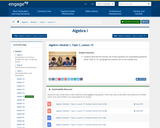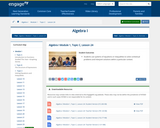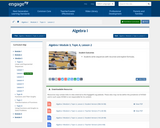
Students understand that the product of two polynomials produces another polynomial; students multiply polynomials.
- Subject:
- Math 1
- Mathematics
- Material Type:
- Lesson
- Author:
- EngageNY
- Date Added:
- 02/02/2020

Students understand that the product of two polynomials produces another polynomial; students multiply polynomials.

Students understand that an equation is a statement of equality between two expressions. When values are substituted for the variables in an equation, the equation is either true or false. Students find values to assign to the variables in equations that make the equations true statements.

Students understand that an equation with variables is often viewed as a question asking for the set of values one can assign to the variables of the equation to make the equation a true statement. They see the equation as a “filter” that sifts through all numbers in the domain of the variables, sorting those numbers into two disjoint sets: the Solution Set and the set of numbers for which the equation is false.
Students understand the commutative, associate, and distributive properties as identities, e.g., equations whose solution sets are the set of all values in the domain of the variables.

Students learn if-then moves using the addition and multiplication properties of inequality to solve inequalities and graph the solution sets on the number line.

Students describe the solution set of two equations (or inequalities) joined by either “and” or “or” and graph the solution set on the number line.

Students solve two inequalities joined by “and” or “or,” then graph the solution set on the number line.

Students learn that equations of the form (x - a)(x - b) = 0 have the same solution set as two equations joined by “or:” x - a = 0 or x - b = 0. Students solve factored or easily factorable equations.

Students interpret equations like 1/x = 3 as two equations “1/x = 3 ” and “x ≠ 0 ” joined by “and.” Students find the solution set for this new system of equations.

Students learn to think of some of the letters in a formula as constants in order to define a relationship between two or more quantities, where one is in terms of another, for example holding V in V = IR as constant, and finding R in terms of I.

Students recognize and identify solutions to two-variable equations. They represent the solution set graphically. They create two variable equations to represent a situation. They understand that the graph of the line ax + by = c is a visual representation of the solution set to the equation ax + by = c.

Students recognize and identify solutions to two-variable inequalities. They represent the solution set graphically. They create two variable inequalities to represent a situation.
Students understand that a half-plane bounded by the line ax + by = c is a visual representation of the solution set to a linear inequality such as ax + by < c. They interpret the inequality symbol correctly to determine which portion of the coordinate plane is shaded to represent the solution.

Students identify solutions to simultaneous equations or inequalities; they solve systems of linear equations and inequalities either algebraically or graphically.

Students create systems of equations that have the same solution set as a given system.
Students understand that adding a multiple of one equation to another creates a new system of two linear equations with the same solution set as the original system. This property provides a justification for a method to solve a system of two linear equations algebraically.

Students use systems of equations or inequalities to solve contextual problems and interpret solutions within a particular context.

Students investigate a problem that can be solved by reasoning quantitatively and by creating equations in one variable.
They compare the numerical approach to the algebraic approach.

Students learn the meaning and notation of recursive sequences in a modeling setting.
Following the modeling cycle, students investigate the double and add 5 game in a simple case in order to understand the statement of the main problem.

Students learn the meaning and notation of recursive sequences in a modeling setting.
Students use recursive sequences to model and answer problems.
Students create equations and inequalities to solve a modeling problem.
Students represent constraints by equations and inequalities and interpret solutions as viable or non-viable options in a modeling context.

Students create equations and inequalities in one variable and use them to solve problems.
Students create equations in two or more variables to represent relationships between quantities and graph equations on coordinate axes with labels and scales.
Students represent constraints by inequalities and interpret solutions as viable or non-viable options in a modeling context.

Students examine sequences and are introduced to the notation used to describe them.

Students write sequences with recursive and explicit formulas.